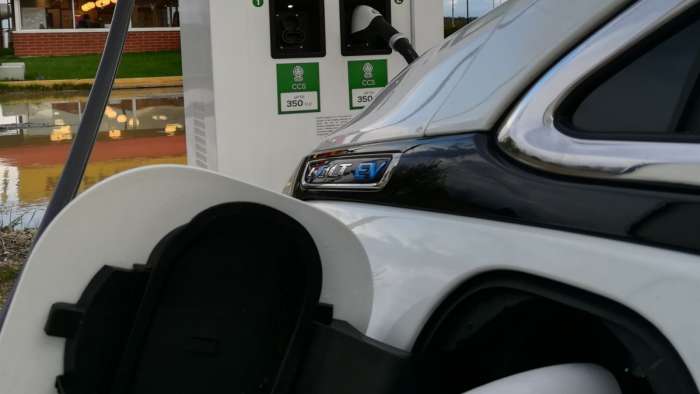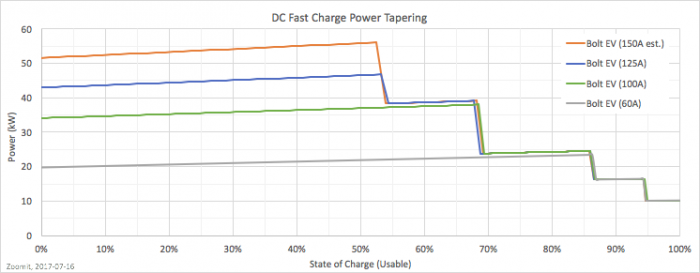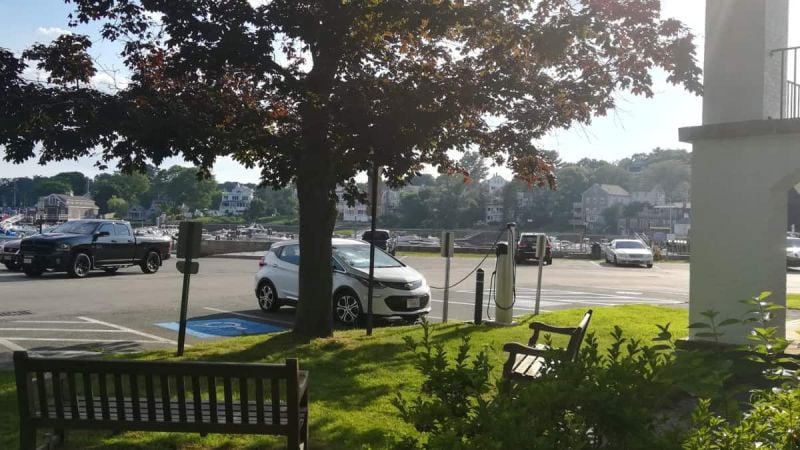It’s common knowledge that driving an electric car like the Chevy Bolt EV is cheaper, both in terms of maintenance and “fueling” the vehicle. Even with a higher sticker price at the time of purchase, electric cars often work out cheaper than their gasoline equivalents over the lifetime of the vehicle, especially if the ICE in question is a gas guzzler.
It’s not unusual for EV drivers to see cost-per-mile numbers in the region of 3 to 5 cents, which is even cheaper than hyper-efficient hybrids like the Toyota Prius. (And not to knock the venerable Prius, but you’re going to have a lot more fun driving electric!)
Even with these low running costs, however, many of us like to squeeze a few more miles from our vehicle and make the cost of electrons go a little further. This story offers five ideas to minimize charging costs from the perspective of a Bolt EV owner, but which should apply to almost everyone who drives a non-Tesla EV.
How Much Does It Cost to Charge a Chevy Bolt EV?
In short, the Bolt EV costs around $7-8 to charge its 60kWh battery pack at home. Electricity rates vary across the U.S. of course, but the average price is 13.27 cents per kWh according to U.S. Energy and Information Administration (EIA) figures for July 2019. In any case, multiply your home rate per kWh by 60 and you have your ballpark cost, without accounting for a relatively small energy loss between wall and vehicle.
We’ll use a 2017 Chevy Bolt EV for this exercise, as that’s my daily driver and the EV with which I have the most experience. Driving habits and vehicle efficiency will inevitably alter some of these numbers, but the Bolt provides a good point for comparison. It lies somewhere in the middle-front portion of the pack in terms of efficiency and range, at least for the 2017 to 2019 model years, and is the most accessible EV in terms of price and nationwide availability in the United States and Canada.
Earlier this year, when my Bolt EV crossed 19,000 miles, I took the time to calculate how much we had spent on charging over our first 18 months of ownership. The results are in the video above, but the bottom line is we spent 3.4 cents per mile and averaged 11.2 cents per kWh across the many forms of charging used.
Because our approach to charging focuses more on the public charging infrastructure than most – and because I pay attention to the cost in such an obsessive manner – we’ve learned a thing or two about how to minimize charging costs. Whether you’re on a road trip across the country or simply opportunity charging around town, the tips below should help to bring down your charging costs in a Bolt or any other non-Tesla EV.
Tips to Minimize Charging Costs in a Chevy Bolt EV
Although this advice comes from the driver’s seat of a Chevy Bolt, it should hold true for most non-Tesla electric vehicles. I separate Tesla because most owners will primarily use the superior Supercharger network, where fees are either waived due to promotions tied to the vehicle or predominantly charged by the energy delivered.
In either case, Tesla vehicles can charge quickly and cheaply in most cases, only using the public charging network for slower L2 sessions or DC fast charging via the CHAdeMO adapter in a pinch.
Here’s a summary of the tips before we dive into each of them:
1. Know Your Taper Points
2. Destination Charging is Essential
3. Explore Your Area
4. Park and Charge
5. Keep an Eye on Idle Fees

Taper Points
All electric vehicles have a charging profile, which refers to how much power they allow the car to take in at any given state of charge. As you reach a higher state of charge, the car requests less power from the charging station in an effort to reduce stress on the battery and improve pack longevity. The step down in power is often called a taper point and it has significant implications for the cost of DC fast charging.
As you can see below, in a Chevy Bolt EV these taper points kick in around 55%, 67%, and several more times above 80% until the vehicle finalizes the charge session.

When DC fast charging on networks that charge you by the minute, it’s important to know your vehicle’s charge profile and understand at which taper points you should end a session to minimize costs. For example, in a Chevy Bolt EV on a 150+ amp charge station it would be optimal to leave after the 55% mark in every session. This allows the car to draw as much energy as possible at its maximum charge rate of 55kW, after which time the power level drops and it takes longer (and costs more) to get the same amount of energy.
In real-world conditions, 55% is often too early to leave and doesn’t make for the most convenient charge stops in terms of time. However, understanding that the car’s charge profile means you can make an informed decision on cost vs. convenience and never spend too much time above 70-80% state of charge, at which point charging most electric vehicles on a per-minute basis becomes much more expensive.
Destination Charging
On any long trip that spans multiple days of driving, an overnight stop at a hotel or campsite is likely to be involved. Road trip charging costs can be significantly reduced if you use this necessary downtime to recharge your EV, as well as your own batteries.
In the case of hotels, Plugshare is an invaluable tool for checking the availability of level 2 charge equipment, assessing reliability, and ensuring your car can use the plug. For a non-Tesla EV, the JDapter Stub that converts Tesla wall chargers to the J1772 standard can be a worthwhile purchase. Although many hotels with charging facilities offer both Tesla and J1772 connections, there may be broken equipment or more Tesla plugs, so the adapter adds a level of redundancy.
At campsites, you’ll be expected to bring your own portable charger, so make sure you understand the kind of hook up you’ll need to connect. Power levels and EVSE standards vary, so it pays to do your research ahead of time and arrive with the right equipment. This handy explanation and visual of National Electrical Manufacturers Association (NEMA) configurations should help you navigate the various types of socket and type of adapter you’ll need to bring along.
In both cases, destination charging is either a nominal fee for the juice or a complementary addition to your stay. There’s nothing quite like waking up to a full charge away from home and knowing that it was included in the price of your stay!
Charge Locally
Closer to home, it’s more likely that you’ll simply plug into your own domestic socket and let the vehicle juice up overnight. Nonetheless, there are times that we forget to plug in, charging gets interrupted, or where we simply need a top-up in the course of a hectic day.
Public charging can also be surprisingly cost-effective if you know where to go and work it into your daily routine. Take some time to browse your local area on Plugshare and scout out some low cost or free charge stations near home, work, and anywhere nearby where you regularly spend some time. You can use the star icon on a station’s listing to save them to your favorites in Plugshare, or alternatively jump out into Google Maps and add a note marking the station’s location.
Often, you’ll find charge stations located in convenient places like shopping plazas and grocery stores, where you can add 7-10 kWh while running errands. Then there are libraries, town halls, recreational areas, and numerous other municipal locations where you might choose to spend time taking a walk, playing with kids, or exploring a new area over lunch. In all these scenarios, charging becomes a convenient addition to an activity you were going to undertake anyway, while simultaneously minimizing your charging costs in other locations.
Park and Charge
An extension to the charge locally tip is to research the opportunities in your area for charging while you park for extended periods of time.
This includes transit stations that offer charging while you take the train or bus into a city center, airport lots that offer charging when you leave your car while traveling, and expensive inner-city parking lots. With the latter, parking fees can be quite expensive but EV charging may be offered as a complementary or low-cost service addition, which helps to offset the premium parking fee.
For anyone in a congested city or simply visiting a new area, using park and charge facilities can add convenience as well as peace of mind. Driving in a busy city, especially one with which the driver is not familiar, can be a frustrating experience. Add finding charge stations to that scenario and it could spoil your experience even before you’ve set foot in the city. Leaving the car to add some inexpensive electrons while you allow a driver with local knowledge to navigate the busy city streets is a much more satisfying experience, where available.
No Idle Fees (Ever!)
Idle fees are the ultimate waste when you’re charging, in terms of both money and time. On Electrify America, for example, you’ll rack up an additional $4 for just 10 minutes plugged in after your charge session has ended.
Tesla also charges idle fees, so this point applies to everyone who drives electric: always monitor your session and be ready to move your vehicle when you’re done charging.
This isn’t just a cost-saving measure, it’s also a matter of good manners. Charging stations are a limited resource and will remain so for the foreseeable future, so it’s essential we treat them as a place to plug in, rather than a privileged parking spot.
Electric cars are already cheap to drive, but it never hurts to shave a few more dollars from the cost of your electrons. Try out the tips above in your area, or on your next road trip, and see how much money you can save.
How much does it cost you to charge your electric vehicle?
If you have any tips of your own to minimize EV charging costs, please share them in the comments.
Steve Birkett is an electric vehicle advocate at Plug & Play EV. You can follow him on Twitter at @plugandplayev, Instagram and YouTube at Plug & Play EV channel to send him EV news tips.












Comments
Great Tips! Well done. We've
Permalink
Great Tips! Well done. We've been driving a Nissan Leaf for a long time. We got a 62kWh Leaf+ in May and I concur with your analysis. Our Leaf is our only vehicle, so it's our only daily driver.
I just want to add a note for frame of reference and clarification. In the first few paragraphs you mention that fully charging the Bolt costs around $7-$8 (your electric rates may vary). I just want to point out that is for a 0-62 kWh FULL charge. That's almost never going to happen. Most normal folks will drive 2-3 days on a full charge and plug in with 35 or more miles available. There is the technology and then there is the behavioral reality. I know people with a Chevy Bolt and I know people with a Tesla Model3. I can tell you that over coffee we discovered we all plug in about every other day with between 40% and 55% charge remaining. My point is that $7-$8 is spread out over more than a few days generally. I'm in the southern US. It's HOT. We use the A/C a lot. We pay about $0.10/kWh. I round up to keep things simple. So far the most it has cost to fuel our EV for the month was $48.90 in August to drive 1968.79 miles.
One last tip to add is that when public charging, carefully check the connector before plugging in. I've found common debris and dirt as well as things that shouldn't be there. Save the repair/replacement cost of a charging port by looking before you plug.
Excellent additions, thank
Permalink
In reply to Great Tips! Well done. We've by Tyler Fawkes (not verified)
Excellent additions, thank you Tyler. I typically use the full charge cost discussion as a precursor to discussing the reality of plugging in as a passive habit, rather than charging as an activity like gassing up. So you're right, with EVs capable of several hundred miles, we're usually just topping up to offset daily driving, not waiting for a full charge.
You seem clueless. It is
Permalink
You seem clueless. It is unfortunate you are not a journalist. To say you have experience with a bolt is either a lie or you really are lost. Too bad. You have really misled many people and not given accurate and good information. Maybe in your world this is okay. So unfortunate.
Your comments seem out of
Permalink
In reply to You seem clueless. It is by Greg Jablonske (not verified)
Your comments seem out of line, compared to the other comments. And my Bolt seems to resemble the author’s assertions.
Steve, great article. I am a
Permalink
Steve, great article. I am a 3 year Bolt owner who drives for Uber. Between 2 Bolts, I have driven over 90k miles. Your assessment of charging issues and cost are spot on.
I need to find where
Permalink
I need to find where electricity is 10 cents/kw. My electric company says it's 12 for the "generation", but after the "delivery" cost, it's about 33! If I get the rated range on my bolt, it costs me 21.78 per charge...without accounting for efficiency... so it's even more.
With current gas prices, my wife's Honda fit costs 23.75 to go 260 miles. So 2$ more and she's full in 10 minutes instead of 7 hours.
If there's a place to live where it's 10 cents/kw after all the fees and additional charges, I'd love to know about it lol.
In Virginia my electricity is
Permalink
In reply to I need to find where by Mister 2 (not verified)
In Virginia my electricity is .13kwh with the exception of peak time. For example from may-September 3pm-7pm is .33kwh. My electric company is also in the process of offering $7 monthly discount for those not charging during peak. Call your electric company and verify pricing.